

Angurvadal. Dáinsleif. When Heðinn offers him compensation for the abduction of his daughter, Högni replies: 'Thou hast made this offer over-late, if thou wouldst make peace: for now I have drawn Dáinsleif, which the dwarves made, and which must cause a man's death every time it is bared,[1] nor ever fails in its stroke; moreover, the wound heals not if one be scratched with it.' —Skáldskaparmál (50), Brodeur's translation[2]
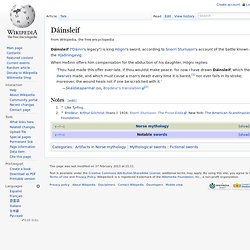
Gram (mythology) In Norse mythology, Gram (Old Norse "wrath")[1] is the name of the sword that Sigurd used to kill the dragon Fafnir.[2] Gram was forged by Volund and originally belonged to Sigurd's father, Sigmund, who received it in the hall of the Völsung after pulling it out of the tree Barnstokkr into which Odin had stuck it where no one else could pull it out.

The sword was destroyed in battle when Sigmund struck the spear of an enemy soldier dressed in a wide brimmed hat and a black hooded cloak. Before he died, Sigmund instructed his wife to keep the pieces so that it might be reforged for the their unborn son (Sigurd), whom she was carrying. The sword was eventually reforged by Regin for Sigurd's use. After it was reforged, it could cleave an anvil in twain. In the Nibelungenlied (ca. 13th century), Siegfried discards Gram after receiving a legendary sword called Balmung; in Richard Wagner's Ring Cycle (1848–1874), it is called Nothung. Gram is depicted on several of the Sigurd stones. Hǫfuð. Hrotti. Hrotti is a sword in the Völsung cycle (Fáfnismál, Völsunga saga, 20).
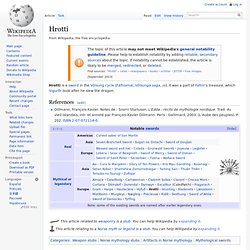
It was a part of Fáfnir's treasure, which Sigurðr took after he slew the dragon. Dillmann, François-Xavier. Notes de : Snorri Sturluson. L'Edda : récits de mythologie nordique. Trad. du vieil-islandais, intr. et annoté par François-Xavier Dillmann. Lævateinn. In Norse mythology, Lævateinn is a weapon mentioned in the Poetic Edda poem Fjölsvinnsmál.
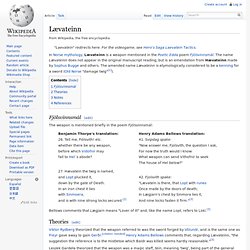
The name Lævateinn does not appear in the original manuscript reading, but is an emendation from Hævateinn made by Sophus Bugge and others. The amended name Lævateinn is etymologically considered to be a kenning for a sword (Old Norse "damage twig"[1]). Fjölsvinnsmál[edit] The weapon is mentioned briefly in the poem Fjölsvinnsmál: Bellows comments that Lægjarn means "Lover of Ill" and, like the name Lopt, refers to Loki.[3] Theories[edit] Leszek Gardeła theorized that the weapon was a magic staff, tein, meaning 'twig', being part of the general word for magic staff gambantein.[4] Notes[edit] References[edit] Legbiter. Mistilteinn. Mistilteinn ("Mistletoe"), also known as Misteltein or Mystletainn, is Hrómundr Gripsson's sword in Hrómundar saga Gripssonar, a legendary saga from Iceland.
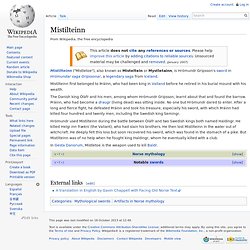
Mistilteinn first belonged to Þráinn, who had been king in Valland before he retired in his burial mound with his wealth. The Danish king Óláfr and his men, among whom Hrómundr Gripsson, learnt about that and found the barrow. Þráinn, who had become a draugr (living dead) was sitting inside. No one but Hrómundr dared to enter. After a long and fierce fight, he defeated Þráinn and took his treasure, especially his sword, with which Þráinn had killed four hundred and twenty men, including the Swedish king Semingr. Hrómundr used Mistilteinn during the battle between Óláfr and two Swedish kings both named Haldingr.
In Gesta Danorum, Mistletoe is the weapon used to kill Baldr. A translation in English by Gavin Chappell with Facing Old Norse Text. Quern-biter. Ridill. Ridill is weapon that appears in Norse Mythology, possessed by the dwarf Regin.

Under the guidance of Regin, Sigurd killed Fafnir, Regin's older brother that had killed their father Hreidmarr and monopolized his treasure. Afterward, Fafnir's heart was cut out and roasted for Sigurd and Regin to eat. According to Poetic Edda, Regin used Ridill to rip out Fafnir's heart. Skofnung. Skofnung was the sword of legendary Danish king Hrólf Kraki.
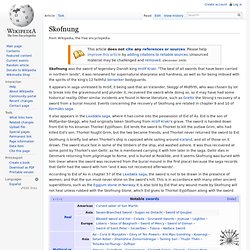
"The best of all swords that have been carried in northern lands", it was renowned for supernatural sharpness and hardness, as well as for being imbued with the spirits of the king's 12 faithful berserker bodyguards. It appears in saga unrelated to Hrólf, it being said that an Icelander, Skeggi of Midfirth, who was chosen by lot to break into the gravemound and plunder it, recovered the sword while doing so, so it may have had some historical reality. Other similar incidents are found in Norse literature, such as Grettir the Strong's recovery of a sword from a burial mound. Events concerning the recovery of Skofnung are related in chapter 9 and 10 of Kormáks saga. It also appears in the Laxdœla saga, where it has come into the possession of Eid of Ás. Skofnung is briefly lost when Thorkel's ship is capsized while sailing around Iceland, and all of those on it drown. Surtr's Flaming Sword.
Tyrfing. Svafrlami secures the sword Tyrfing.

Tyrfing, Tirfing or Tyrving (The name is of uncertain origin, possibly connected to the Terwingi) was a magic sword in Norse mythology, which figures in the Tyrfing Cycle, which includes a poem from the Poetic Edda called Hervararkviða, and the Hervarar saga. The name is also used in the saga to denote the Goths. The form Tervingi was actually recorded by Roman sources in the 4th century. The dwarves made the sword, and it shone and gleamed like fire. However, in revenge they cursed it so that it would kill a man every time it was drawn and that it would be the cause of three great evils.